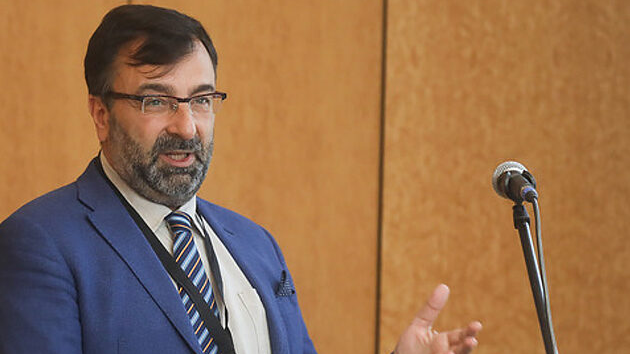JEC Composites Magazine interviewed Roberto Frassine, President of EuCIA, the European Composites Industry Association, about the sustainability and circularity of the composites industry.
This article is reproduced with the kind permission of JEC.
Professor Roberto Frassine has been an expert in the viscoelastic properties of polymers and composites for thirty years, with more than 70 technical and scientific international publications. He is President of Assocompositi, the Italian composites industry association, and President of UNIPLAST, the Italian national standards organization for plastics and composites.
He is a full professor of Polymeric and Composite Materials at the Industrial Chemistry and Chemical Engineering Department of the Politecnico di Milano.
JEC Composites Magazine: From your perspective, what are the current trends within the composites industry?
Roberto Frassine: Composite materials maintain a high potential for growth, especially in energy, construction and transportation applications. The wind energy sector is expected to grow significantly and a good potential can also be foreseen for lightweight hydrogen tanks. The construction industry is expected to develop due to the upcoming introduction of a new standard for composite construction in the Eurocodes. Sustainability and circularity issues are the next “big thing” – EuCIA is working actively to prepare for the discussion and a new position paper is available on our website.
JEC Composites Magazine: What’s EuCIA position about the topic of composite materials recycling?
Roberto Frassine: Our Sustainability Committee has been engaged in defining the industry’s position on boundary conditions on this topic. With our position paper, we successfully demonstrated that not only are composites recyclable, but also that the recycling techniques available are very effective, we want to follow up on the proposal for a cross-industry circular composites alliance, so that the potential of our materials can be realized at the industrial scale.
We think composite materials can perform the best because of their versatility, durability and resistance to environmental stresses. It will soon be crucial to develop guidelines with circular economy schemes (design for circularity).
EuCIA would support the creation of an alliance with all stakeholders of the composites industry. We are already discussing with Wind Europe and EBI together with EuCIA members to develop a proposal document stating the objectives, which will be followed by a call to invite stakeholders to participate. As a result, we confirm that cement co-processing is today an effective solution, and we are closely working with CemBureau to develop this recycling route.
JEC Composites Magazine: The anticipated EU roadmap for end-of-life recreational boats will soon be launched by the European Commission and the European Boating Industry. What can you tell us about this?
Roberto Frassine: The strategy promoted by EBI – which has a time horizon to 2025 – is encapsulated in the mission statement “Advancing and representing a sustainable boating and nautical tourism industry #MadeInEurope”.
In 2020, the European Commission confirmed to EBI that measures to reduce greenhouse gas emissions from recreational boats will be included in the review of the Recreational Craft Directive (RCD) as a direct consequence of the European Green Deal, which has the target of making the EU carbon-neutral by 2050. Since then, EBI and the European Commission Directorate-General for Maritime Affairs (DG MARE) have been jointly leading a working group on end-of-life boats. The aim of this collaboration is to develop an EU roadmap that EU countries can follow to set up their own dismantling systems. We are currently involved in this initiative together with the European Boating Association (EBA), the International Council of Marine Industry Associations (ICOMIA) and other associations representing composite end-users.
We mention the French initiative, approved by the ministry of ecological transition, called APER, composed of boat builders. It is a unique organization that has been showcased as a good example by the EU Commission’ DG MARE.
JEC Composites Magazine: Can you give us other examples of projects EuCIA is currently working on?
Roberto Frassine: EuCIA’s mission consists in supporting the sustainable growth of the composites industry and promoting the development of a flourishing business environment, taking advantage of the combined expertise of its members.
We are active in various fields:
- Innovation in composites applications, with the MaxBlade Horizon Europe project to develop the world’s largest tidal turbine blades.
- Innovation in end-of-life composite materials, with the Refresh Horizon Europe project, aimed at recycling composites wind blades.
- Sharing best practices: we are part of the Global Composites Sustainability Coalition (GCSC).
- Promoting standardization: the July 2022 the EN/TS 19101 “Prospect for new guidance in the design of FRP” was recently approved by 23 member states of CEN. This document, developed by CEN/TC250/WG4, has received the full support of EuCIA, both technically and financially.
JEC Composites Magazine: What are the toughest challenges the composites industry is facing in implementing/adopting new sustainable technologies?
Roberto Frassine: We believe that the transition will be smooth. In this regard, we are organizing together with JEC, during JEC World a conference entitled “Less is better: reducing waste, costs, energy & time for sustainable composites manufacturing“, to which we invite all readers of this article. This session will provide a good overview of the challenges but also opportunities our industry is facing in the near future.
Website: www.eucia.eu
Website: www.jeccomposites.com
